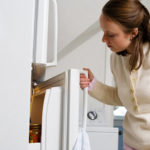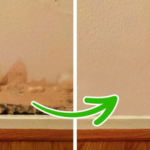The frequent humid weather makes mold, bacteria, and viruses thrive. Clothes are items that absorb moisture, so even after drying, you may feel that they are not completely dry. That’s why the wardrobe is a location that is prone to mold and moisture. Apply the following tips to keep your wardrobe dry and airy.

The humid weather causes water to accumulate in the house, leading to mold growth
Close the doors tightly
When the weather is warm and dry, opening the doors allows bacteria to be eliminated, brings in light and sunshine. However, when it’s rainy and humid, opening the doors lets in even more moisture. Therefore, close the doors and windows tightly to limit the influx of damp air, preventing it from bringing moisture into the house. Keeping the air in the house dry during humid days also helps prevent water vapor from entering the wardrobe, keeping the surfaces and the surrounding area dry, preventing mold and musty odors from forming on the clothes.
Adjust the wardrobe position to avoid contact with the wall
If the wardrobe is too close to the wall, especially wooden wardrobes, adjust the distance to about 5cm away from the wall. The wall is prone to moisture, and when the wardrobe is placed against the wall, the trapped moisture will seep into both the wall and the wardrobe, causing them to be unable to dry properly. Therefore, readjust the position of the wardrobe to ensure it is not in direct contact with the wall, and the bottom of the wardrobe is not in contact with the floor.

Avoid placing the wardrobe directly against the wall to prevent mold and moisture
Prevent moisture in the wardrobe with dried tea leaves and coffee
Before storing clothes in the wardrobe, make sure they are clean and completely dry. Do not store clothes that are still damp or slightly moist. Classify your clothes clearly before storing them, folding some and hanging others. You can use moisture-absorbing bags or place dried tea leaves, coffee, or dried rice in the corners of the wardrobe to help absorb moisture better. Tea and coffee also have excellent deodorizing effects. Check them weekly, and if they are too damp, replace them with fresh ones.
Use newspaper to absorb moisture
In the gaps between the wardrobe and the wall, and between the wardrobe and the floor, stuff dry newspaper or cardboard to absorb moisture.
Prevent mold and musty odors in clothes with eucalyptus oil
Place a bottle of eucalyptus oil in the wardrobe, open the cap, and stand it upright to avoid spilling the oil on white clothes. You can also use eucalyptus-infused sachets and place them in the corners of the wardrobe. Eucalyptus oil kills bacteria and leaves a pleasant fragrance on the clothes in the wardrobe.
If the wardrobe has mold, follow these steps:
If you follow the above moisture-proofing methods for the wardrobe during humid weather, but mold still appears, you will need to take action.
First, remove all the clothes from the wardrobe and thoroughly inspect each item, especially those stored at the bottom or in the corners of the wardrobe, to see if they are affected by mold and dampness.
Take a clean, soft cloth and dampen it with vinegar or lemon juice. Wipe the entire wardrobe, paying special attention to the compartments, wiping from the inside to the outside. If there are many mold spots, you may need to use specialized cleaning solutions.
Finally, clean the wardrobe with water and a clean cloth, allowing it to completely dry before returning the clothes to the wardrobe.
To prevent the return of mold, regularly check the wardrobe for any gaps and address them promptly.
Why Is the Refrigerator Smelling Bad and What Are the Consequences?
If you’re experiencing a strange smell coming from your refrigerator, it can be a sign that something may be off. Not only is it a nuisance, but it can also adversely impact the quality of your foods. Here’s an exploration of the various causes of this issue, as well as some strategies to get rid of the smell.






































